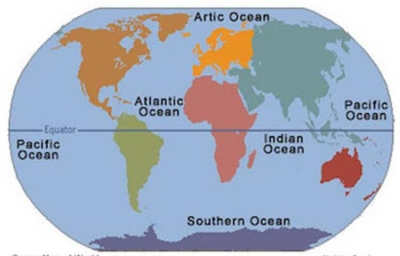
|
An ocean is a huge, continuous body of salt water. Oceanographers identify five major oceans on the basis of geography and the continents that surround them. These are the Pacific, Atlantic, Indian, Arctic and Southern (also known as Antarctic) Oceans. They cover about one-third of Earth’s surface and contain about 97 per cent of the world’s water. |
Pacific Ocean
The Pacific Ocean is the largest ocean covering more than 30% of the Earth. This is close to half of the water on Earth.
It touches the west coast border of the Americas along with east Asia and Australia.
The equator divides the Pacific Ocean into two separate parts – the North Pacific Ocean and South Pacific Ocean.
Pacific means “peaceful” in Latin. It has the deepest trenches with an average depth of 3800m.
Atlantic Ocean
The Atlantic Ocean is situated between the Americas and European/African continents. The Atlantic Ocean is the second-largest and saltiest ocean in the world.
It resembles an S-shape between the Americas, Europe, and Africa. “Atlantic” originated from the Greek god “Atlas” who carried the sky for eternity.
The ocean bottom is composed of mid-Atlantic Ridge. This submarine mountain range extends all the way from Iceland to 58 degrees South latitude. It’s part of the longest mountain range in the world.
Indian Ocean
The Indian Ocean is the third largest ocean surrounding a densely populated region. It contains an additional 20% of the water on Earth’s surface.
It borders India in the North, East Africa, Australia, and the Southern Ocean. Because of the higher water temperature, it has limited marine life.
Since about 800 A.D. the Indian Ocean has played an important role in trading. For centuries, navigators have sailed along major ocean currents for shipment routes.
It is bounded by 4 tectonics plate boundaries and may include an additional plate boundary. It is the geologically youngest of the 5 oceans with spreading ridges at divergent plate boundaries.
Southern Ocean
In 2000, the Southern Ocean is the newest ocean recognized by the International Hydrographic Organization. It borders Antarctica in its entirety.
In terms of size, it’s the fourth-largest at 20,327,000 square kilometers. It extends out to 60 degrees South latitude.
It’s an extreme environment and is the least understood of the 5 oceans. This is because it is unexplored, far from populated areas, and has a severe climate.
Despite the Southern Ocean being unexplored, about 80% of all oceans in the world are unexplored. There’s still a lot of work to do for ocean exploration.
Arctic Ocean
The Arctic Ocean is the world’s smallest and shallowest ocean of all 5 oceans. Further to this, it is the coldest and least salty ocean.
In size, the Arctic Ocean is about the size of Russia. Because it’s located at the North Pole, the Arctic Ocean has polar ice. But over the years, glaciers have melted threatening sea levels to rise.
Despite the IHO recognizing it as the “Arctic Ocean”, some oceanographers still call it the “Arctic Sea”.
The Arctic Ocean is the most diverse in terms of fish species. It has a wide variety of marine species including whales, jellyfish, etc.
But because of its frigid temperatures, it has little plant life. This makes it one of the most fragile ecosystems on the planet.
Credit: EARTHHOW
Picture Credit : Google




